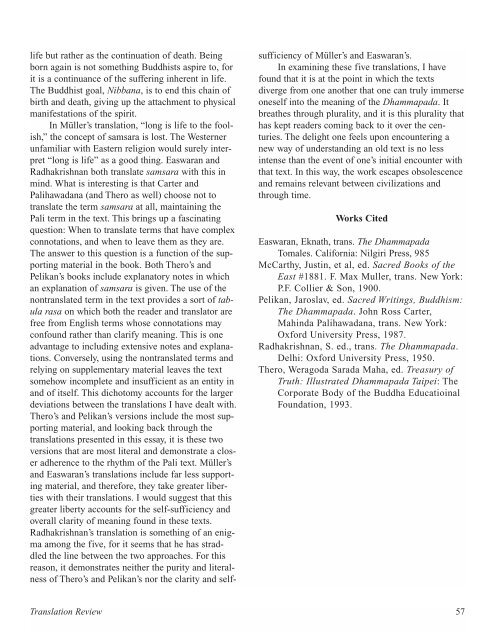Translation Review - The University of Texas at Dallas
Translation Review - The University of Texas at Dallas
Translation Review - The University of Texas at Dallas
You also want an ePaper? Increase the reach of your titles
YUMPU automatically turns print PDFs into web optimized ePapers that Google loves.
life but r<strong>at</strong>her as the continu<strong>at</strong>ion <strong>of</strong> de<strong>at</strong>h. Being<br />
born again is not something Buddhists aspire to, for<br />
it is a continuance <strong>of</strong> the suffering inherent in life.<br />
<strong>The</strong> Buddhist goal, Nibbana, is to end this chain <strong>of</strong><br />
birth and de<strong>at</strong>h, giving up the <strong>at</strong>tachment to physical<br />
manifest<strong>at</strong>ions <strong>of</strong> the spirit.<br />
In Müller’s transl<strong>at</strong>ion, “long is life to the foolish,”<br />
the concept <strong>of</strong> samsara is lost. <strong>The</strong> Westerner<br />
unfamiliar with Eastern religion would surely interpret<br />
“long is life” as a good thing. Easwaran and<br />
Radhakrishnan both transl<strong>at</strong>e samsara with this in<br />
mind. Wh<strong>at</strong> is interesting is th<strong>at</strong> Carter and<br />
Palihawadana (and <strong>The</strong>ro as well) choose not to<br />
transl<strong>at</strong>e the term samsara <strong>at</strong> all, maintaining the<br />
Pali term in the text. This brings up a fascin<strong>at</strong>ing<br />
question: When to transl<strong>at</strong>e terms th<strong>at</strong> have complex<br />
connot<strong>at</strong>ions, and when to leave them as they are.<br />
<strong>The</strong> answer to this question is a function <strong>of</strong> the supporting<br />
m<strong>at</strong>erial in the book. Both <strong>The</strong>ro’s and<br />
Pelikan’s books include explan<strong>at</strong>ory notes in which<br />
an explan<strong>at</strong>ion <strong>of</strong> samsara is given. <strong>The</strong> use <strong>of</strong> the<br />
nontransl<strong>at</strong>ed term in the text provides a sort <strong>of</strong> tabula<br />
rasa on which both the reader and transl<strong>at</strong>or are<br />
free from English terms whose connot<strong>at</strong>ions may<br />
confound r<strong>at</strong>her than clarify meaning. This is one<br />
advantage to including extensive notes and explan<strong>at</strong>ions.<br />
Conversely, using the nontransl<strong>at</strong>ed terms and<br />
relying on supplementary m<strong>at</strong>erial leaves the text<br />
somehow incomplete and insufficient as an entity in<br />
and <strong>of</strong> itself. This dichotomy accounts for the larger<br />
devi<strong>at</strong>ions between the transl<strong>at</strong>ions I have dealt with.<br />
<strong>The</strong>ro’s and Pelikan’s versions include the most supporting<br />
m<strong>at</strong>erial, and looking back through the<br />
transl<strong>at</strong>ions presented in this essay, it is these two<br />
versions th<strong>at</strong> are most literal and demonstr<strong>at</strong>e a closer<br />
adherence to the rhythm <strong>of</strong> the Pali text. Müller’s<br />
and Easwaran’s transl<strong>at</strong>ions include far less supporting<br />
m<strong>at</strong>erial, and therefore, they take gre<strong>at</strong>er liberties<br />
with their transl<strong>at</strong>ions. I would suggest th<strong>at</strong> this<br />
gre<strong>at</strong>er liberty accounts for the self-sufficiency and<br />
overall clarity <strong>of</strong> meaning found in these texts.<br />
Radhakrishnan’s transl<strong>at</strong>ion is something <strong>of</strong> an enigma<br />
among the five, for it seems th<strong>at</strong> he has straddled<br />
the line between the two approaches. For this<br />
reason, it demonstr<strong>at</strong>es neither the purity and literalness<br />
<strong>of</strong> <strong>The</strong>ro’s and Pelikan’s nor the clarity and self-<br />
sufficiency <strong>of</strong> Müller’s and Easwaran’s.<br />
In examining these five transl<strong>at</strong>ions, I have<br />
found th<strong>at</strong> it is <strong>at</strong> the point in which the texts<br />
diverge from one another th<strong>at</strong> one can truly immerse<br />
oneself into the meaning <strong>of</strong> the Dhammapada. It<br />
bre<strong>at</strong>hes through plurality, and it is this plurality th<strong>at</strong><br />
has kept readers coming back to it over the centuries.<br />
<strong>The</strong> delight one feels upon encountering a<br />
new way <strong>of</strong> understanding an old text is no less<br />
intense than the event <strong>of</strong> one’s initial encounter with<br />
th<strong>at</strong> text. In this way, the work escapes obsolescence<br />
and remains relevant between civiliz<strong>at</strong>ions and<br />
through time.<br />
Works Cited<br />
Easwaran, Ekn<strong>at</strong>h, trans. <strong>The</strong> Dhammapada<br />
Tomales. California: Nilgiri Press, 985<br />
McCarthy, Justin, et al, ed. Sacred Books <strong>of</strong> the<br />
East #1881. F. Max Muller, trans. New York:<br />
P.F. Collier & Son, 1900.<br />
Pelikan, Jaroslav, ed. Sacred Writings, Buddhism:<br />
<strong>The</strong> Dhammapada. John Ross Carter,<br />
Mahinda Palihawadana, trans. New York:<br />
Oxford <strong>University</strong> Press, 1987.<br />
Radhakrishnan, S. ed., trans. <strong>The</strong> Dhammapada.<br />
Delhi: Oxford <strong>University</strong> Press, 1950.<br />
<strong>The</strong>ro, Weragoda Sarada Maha, ed. Treasury <strong>of</strong><br />
Truth: Illustr<strong>at</strong>ed Dhammapada Taipei: <strong>The</strong><br />
Corpor<strong>at</strong>e Body <strong>of</strong> the Buddha Educ<strong>at</strong>ioinal<br />
Found<strong>at</strong>ion, 1993.<br />
<strong>Transl<strong>at</strong>ion</strong> <strong>Review</strong> 57

















